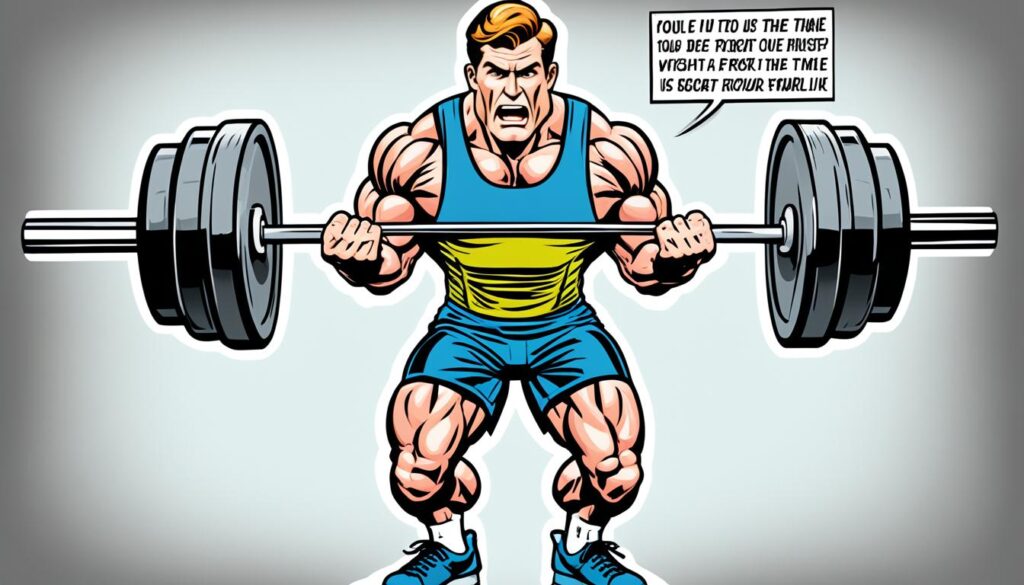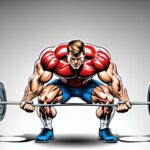The Ultimate Guide to deadlifts muscles worked
Did you know that deadlifts, a staple exercise in many strength training routines, engage more than 85% of your body’s muscles? That’s right, this compound movement activates a wide range of muscle groups, making it one of the most effective exercises for a full-body workout.
Key Takeaways:
- Deadlifts target more than 85% of your body’s muscles
- They are a compound exercise that engages both the upper and lower body
- Proper form and technique are crucial for maximizing the benefits of deadlifts
- Variations like close grip deadlifts and weighted deadlifts can intensify muscle engagement
- Incorporating deadlifts into your home gym workout routine can lead to significant strength gains and overall fitness improvement
Engaging the Major Muscle Groups
Deadlifts are a compound exercise that targets the major muscle groups in your body. By performing deadlifts correctly, you can effectively engage multiple muscles simultaneously, leading to enhanced strength and overall fitness. In this section, we will explore the primary muscle groups worked during deadlifts.
When you perform a deadlift, a variety of muscles work together to execute the movement. Let’s take a closer look at the major muscle groups involved:
- Hamstrings: The hamstrings, located at the back of your thighs, play a crucial role in the deadlift. They are responsible for extending your hips during the upward phase of the lift.
- Quadriceps: Situated at the front of your thighs, the quadriceps are heavily engaged during deadlifts. They help in extending your knees and stabilizing the lower body.
- Glutes: Your gluteal muscles, including the gluteus maximus, medius, and minimus, are activated throughout the deadlift movement. They assist in the extension of the hips.
- Erector Spinae: This group of muscles, located along the spine, supports the back during deadlifts and helps maintain proper posture.
- Core Muscles: The muscles of the core, including the rectus abdominis, obliques, and transverse abdominis, work to stabilize your spine, keeping it strong and protected during the lift.
Engaging these major muscle groups in a deadlift not only strengthens them individually but also improves their coordination. This translates to improved overall performance in various physical activities and sports.
Now that we have discussed the major muscle groups worked during deadlifts, let’s move on to the next section to explore how deadlifts specifically target the lower body muscles.
Targeting the Lower Body
When it comes to deadlifts, the lower body is the primary focus. These compound exercises engage multiple muscles in your glutes, quadriceps, hamstrings, and calves, resulting in a comprehensive lower body workout.
Let’s take a closer look at each of these muscle groups and the crucial role they play in executing a deadlift:
Glutes
The glutes, which consist of the gluteus maximus, gluteus medius, and gluteus minimus, are some of the largest and most powerful muscles in the body. They play a vital role in hip extension, which is a fundamental movement pattern in deadlifting. By activating and strengthening your glutes through deadlifts, you can improve your overall athleticism and lower body power.
Quadriceps
The quadriceps, located at the front of your thigh, are responsible for knee extension and stability. During a deadlift, the quadriceps work to straighten your knees and provide stability throughout the movement. Strengthening your quadriceps through deadlifts can enhance your leg strength, improve athletic performance, and support knee health.
Hamstrings
Your hamstrings are a group of muscles located at the back of your thigh. They play a crucial role in hip extension and knee flexion, making them vital for deadlifting. Engaging and strengthening your hamstrings through deadlifts can improve your overall lower body strength, enhance athletic performance, and reduce the risk of hamstring injuries.
Calves
The calves, consisting of the gastrocnemius and soleus muscles, are responsible for ankle plantar flexion, which allows you to stand on your toes. Although the calves may not be as prominently engaged during deadlifts as the other mentioned muscle groups, they still play a supportive role in providing stability and balance.
To further intensify the engagement of these lower body muscles, you can try close grip deadlifts. This variation involves gripping the barbell with your hands placed closer together than in a conventional deadlift. By narrowing your grip, you place more emphasis on the lower body muscles, particularly the glutes, hamstrings, and quadriceps.
Incorporating close grip deadlifts into your training routine can help you target and strengthen your lower body muscles even more effectively.
Now that we’ve explored the muscles worked in the lower body during deadlifts, let’s move on to section 4, where we’ll discuss how deadlifts can strengthen the upper body.
Strengthening the Upper Body
While deadlifts are primarily known for their lower body benefits, they also play a significant role in strengthening the muscles of the upper body. The upper back muscles, particularly the erector spinae and latissimus dorsi, are engaged during deadlifts, contributing to overall upper body strength and stability.
The erector spinae muscles, located along the spine, are responsible for maintaining proper posture and spinal alignment during the deadlift exercise. These muscles work in tandem with the core muscles to provide stability and prevent injury. By incorporating deadlifts into your workout routine, you can strengthen the erector spinae and improve your overall back strength.
The latissimus dorsi, often referred to as the lats, are the largest muscles in the upper body. These muscles play a crucial role in pulling movements and are activated during the upward phase of the deadlift. Strengthening the lats not only improves your deadlift performance but also contributes to a well-rounded upper body strength.
Speaking of upper body strength, grip strength is an essential component during deadlifts. A strong grip allows you to maintain control of the bar and sustain proper form throughout the movement. Incorporating exercises like bench press or weighted deadlifts can further enhance grip strength and promote upper body engagement during deadlifts.
“By engaging and strengthening the muscles of the upper body, deadlifts provide a comprehensive workout that targets both the lower and upper body. The erector spinae and latissimus dorsi are key players in this exercise, contributing to postural support and overall back strength.”
To summarize, deadlifts not only target the muscles in your lower body but also engage and strengthen the muscles of your upper body. By incorporating deadlift variations such as bench press or weighted deadlifts, you can further maximize upper body engagement and reap the benefits of a full-body workout.

| Muscle | Primary Function |
|---|---|
| Erector Spinae | Maintains spinal alignment and posture |
| Latissimus Dorsi (lats) | Contributes to pulling movements and overall back strength |
Conclusion
In conclusion, deadlifts are a powerful exercise for targeting multiple muscle groups and achieving a well-rounded workout. By incorporating deadlifts into your home gym routine, you can effectively engage and strengthen key areas of your body, including the lower body, upper body, and core.
Deadlifts specifically target the muscles in your lower body, such as the glutes, quadriceps, hamstrings, and calves. These movements help to build strength, improve stability, and enhance overall performance.
Furthermore, deadlifts also engage and strengthen the muscles in your upper body, particularly the erector spinae and latissimus dorsi. This contributes to improved posture, increased grip strength, and enhanced upper body stability.
To reap the full benefits of deadlifts, it is essential to prioritize proper form and technique. This not only maximizes muscle engagement but also helps prevent injuries. Always start with lighter weights and gradually increase as you gain strength and confidence.
So, whether you’re a beginner or a seasoned fitness enthusiast, incorporating deadlifts into your training regimen can unlock the full potential of your muscles. Experience the transformative effects of deadlifts and take your fitness journey to the next level.
FAQ
What are the main muscle groups worked during deadlifts?
Deadlifts primarily target the major muscle groups in your body, including the glutes, quadriceps, hamstrings, lower back, upper back, and core muscles.
How can deadlifts strengthen my lower body?
Deadlifts are excellent for strengthening your lower body. They specifically target the glutes, quadriceps, hamstrings, and calves, helping to build strength and increase muscle mass in these areas.
Can deadlifts also strengthen my upper body?
Yes, deadlifts engage and strengthen the muscles in your upper body, particularly the muscles in your upper back, such as the erector spinae and latissimus dorsi. Incorporating exercises like the bench press or weighted deadlifts can further enhance upper body engagement.
How important is grip strength when performing deadlifts?
Grip strength is crucial for maintaining control of the barbell during deadlifts. It helps to engage the muscles in your hands, wrists, and forearms. Additionally, improving your grip strength can have significant carryover benefits to other exercises.
Are there any variations of deadlifts that I can incorporate into my workout?
Yes, there are several variations of deadlifts that you can try to further target specific muscle groups or challenge yourself in different ways. One example is the close grip deadlift, which increases the engagement of the muscles in your upper back and core.
